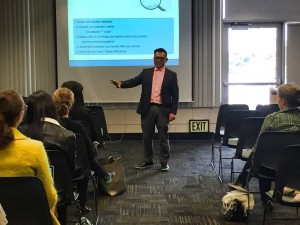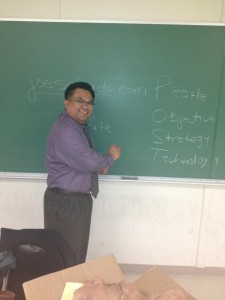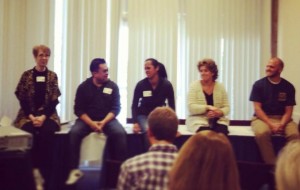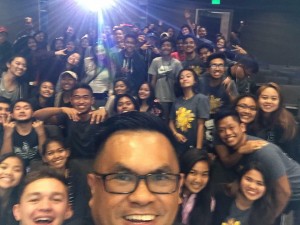I started my blog because I needed a place to share ideas and process my thoughts. Six years after my first post on October 21, 2010, I posted 383 articles on professional and personal topics. As I read through what I have written, it’s fascinating how my perspectives have evolved in some ways, yet some of my core principles have not changed. Below are thoughts on my personal values, principles, leadership, student affairs, and technology.
Personal Values and Principles
Reasons I Value Diversity and Inclusion in The Workplace
I was interviewed for a course on ethical leadership two months ago. One of the questions was what drives my value system and priorities at work. I suppose I had not thought of this before. Still, during that interview, I realized that providing equal access to opportunities, inclusion, and appreciating diversity are very important values of mine. As I was asked additional questions about why these were so important to me, I realized it was my experiences feeling marginalized while growing up, in college, and even at work when I did not fit in the norms that drive me to ensure those around me have the opportunities to be included and differences are valued. [More …]
A Reflection on My Career in Student Affairs
Working with students and other activities outside my technologist role is where I find most personal satisfaction. Serving on the student fee advisory committee, student resource team, reading admissions applications, and serving as a student organization advisor provide me with reminders of who I am ultimately serving, the students, and that I can somehow make a difference in their lives is what motivates me. As an aside, moving forward with new technologies like social media and mobile web, I have also found these activities very critical to my understanding of the culture and trends of students today. [More…]
Reflecting on Why I Love My Job in Student Affairs
If I view my job in student affairs IT as just about computers, I’m missing the bigger picture. Ultimately, it’s about helping students succeed through technology and my roles as a discussion leader, organizational advisor, mentor, and facilitator. My role as the director/leader in my IT organization is about helping my staff and colleagues grow, creating an environment where they feel personally satisfied with what they do and contribute. Ultimately, my job is about helping people and helping build communities. I am also part of the UCSB community. [More…]
Nowhere I’d Rather Be Than in Student Affairs
It is during the most challenging times of my job when I think how blessed I am to have my job in student affairs, specifically as an IT leader within student affairs. The sometimes convoluted nature of higher education bureaucracy, the pressure of delivering critical technology services with limited resources, and juggling competing priorities make it challenging some days. But, even with these challenges, actually, because of these challenges, I feel blessed to have my job. I can easily look beyond the day-to-day frustrations because I know that at the end of the day, what matters is that my colleagues and I, the work we do, have a very important purpose – to help students succeed. [More…]
UCSB STEP Program – Nourishment for My Soul
Personally, the STEP program provides me with the opportunity to build connections with the students. Even if most of them will never contact me again, I consider it a privilege and honor to be a part of their introduction to their new lives at UCSB. My one-week STEP experience is enough to nourish my soul and provide me with the motivation and a sense of purpose for the rest of the year. [More…]
Why I Love My Job in Student Affairs at UCSB
Through technologies, I help serve the UCSB community so students can successfully navigate the university, prepare them for their careers, and develop as human beings. However, the personal connections I’ve made with the few students make me realize how blessed I am to be in a position where I can make a difference in their lives. [More…]
Pilipino Graduation and What My Job Really Means
One of the reasons why I actively seek out opportunities to work with students, in addition to the fact that I do find enjoyment in working with them, is because I do feel that for me to be able to do my job effectively; I need to be reminded of who I serve. These students have come to the university for different reasons and aspirations. For many of them, attending UCSB required their families to sacrifice. These students must find ways to succeed at the university against increasing tuition and declining resources. [More…]
Thoughts on Leadership
My Professional Vision as Higher Education IT Leader (DRAFT)
How often have you thought about your core ideologies and your future as a professional? I haven’t myself, but as I led my organization through a strategic planning process and learned how to develop successful organizations, I began to think about how I could apply that process personally. Using ideas from a book by Jim Collins called “Built to Last: Successful Habits of Visionary Companies,” I came up with some initial thoughts below. [More…]
IT Organizational Management & Leadership
One of the lessons I’ve learned is that to be an effective organizational leader, you need to be an effective manager, and to be an effective manager, you need to be an effective leader. In short, leadership and management go hand in hand when delivering results. [More…]
Leading in Stressful Times
As managers, don’t lose sight of the idea that our staff are human beings and not just units of resources. If organizations are to be productive, managers must make themselves available and build relationships with staff to build an engaged workforce. Being short-sighted and just giving orders to complete tasks can lead to unintended and counterproductive consequences. [More…]
Assertiveness: My Leadership Challenge as an Asian American
Throughout my career, one personal trait that’s been perceived as negative regarding my leadership style has been my assertiveness or lack of. From the feedback I’ve received, I’ve been seen as not direct and not confrontational when dealing with conflicts. Whether that’s because of my personality or cultural upbringing, I don’t know why I have not been seen as “assertive” as other folks would like me to be. [More..]
My IT Organization’s Guiding Values and Principles
As I’ve been with my organization for more than 15 years, I have a good sense of our culture, strengths, capabilities, and areas of improvement. I firmly believe that we are a very capable organization, proven by what we’ve been able to do and we can continue/improve our delivery of quality solutions and excellent customer service. We have a dedicated, highly knowledgeable, and skilled team with strong support from our senior management. For these reasons, I strive for the idea that when people think of THE model of higher education IT, they think of UCSB SIS&T!
I believe my organization’s guiding values and principles must be able to stand through time in the midst of ever-changing technology landscapes and dynamic customer services and needs. It is with this mindset that these guiding values and principles were formulated. [More…]
Leadership is About Connecting, More than Communicating
Leadership, in my opinion, is about influence, not control. A leader’s ability to influence others ultimately depends on how they are perceived by those they lead. Leaders who can establish connections, which can make others feel like they matter and are understood, are the ones who will have the most influence. [More…]
Leadership – Bruce Lee style
“I can best describe Joe Sabado as the ‘Bruce Lee’ of managers. People would ask Bruce Lee what his ‘system’ was, saying he didn’t have a ‘system.’ His style was the style of no style. Likewise, Joe doesn’t have a management style because no single method works with everyone, or at all times.”
“Joe is a master at understanding people and their current situation. Joe always looks to adapt himself to the other person, and even to the other person’s mood.” [More…]
My Perspective on IT Leadership for 2012
The demands of our customers and employees are changing fast, and as an organization, our ability to adapt, not react, is critical. One challenge I see in my position is promoting our core mission while keeping up with the trends. [More…]
Student Affairs and Technology
Student Affairs Digital Technology for Student Success
Academic and co-curricular programs, student services, enrollment management services, and other administrative services offered by higher ed institutions are aimed to support and promote student learning, development, and success. [More…]
Student Affairs Org Technology Leadership Competencies – MindMap
What competencies are required to be an effective student affairs technology leader at an organizational level? This is a question I pondered while reviewing the Technology Competency Area within the ACPA/NASPA Professional Competency Area for Student Affairs Educators. I specifically mentioned “at an organizational level” because managing/leading the appropriate/effective use of technology at the divisional level differs from one who is leading the efforts at the national or individual levels. [More…]
Technology Responsibilities & Qualifications for Senior Student Affairs Officers
Technology leadership must be present at the highest level of student affairs organizations. At the minimum, CSAOs cannot abdicate their roles as information technology managers, and they must either develop the skills, knowledge, and dispositions as described in the new technology competency area and/or include a position that can provide leadership to lead effective adoption, utilization, and assessment/evaluation of technology in student affairs. [More…]
Future of Student Affairs and Information Technology
Dean of Student Affairs Technology – A Proposed Role
How come there are Dean of Academic Technology positions but not a Dean of Student Affairs Technology? This is a question that crosses my mind from time to time. According to Kevin Guidry’s research on the history of student affairs and technology, technology has been a part of student affairs for decades. Still, I’m unsure why such a position has not existed before. [More…]
A Glimpse of Student Affairs in the (Near) Future?
There will come the point shortly when these five forces — mobile, social media, data, sensors (internet of things), and location, as Robert Scoble and Shel Israel call them in their book “Age of Context” will transform student affairs. [More…]
The Need for a Common Higher Education Data Model
It seems to me that until a common structured data higher education data model that can be used as a standard exists, higher education institutions will not be able to develop a holistic assessment of student success and provide services such as advising that use curricular and co-curricular information. [More…]
Technologies, Assessment, and the Future of Student Affairs
The future of student affairs will include consumer technologies including mobile, data, sensors, social media, cloud, wearable computing, and location-based systems. This possibility is by no means a stretch if one is to consider what already exists outside the world of academia and follow consumer technology trends. [More…]




